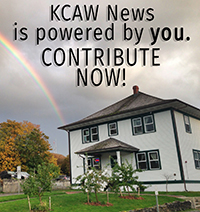
Doug Osborne remains upbeat about Sitka’s health. In some areas like the Social & Economic Factors which contribute to health, Sitka leads the state. (KCAW photo/Robert Woolsey)
Sitka is back in the top ten most healthy Alaskan communities.
After a two-year slump that saw Sitka drop to eleventh-place last year, and fourteenth in 2015, the town is back to ninth overall — this according to the County Health Rankings & Roadmaps, a national project of the Robert Wood Johnson Foundation.
In 2014, Sitka ranked number 2 behind Juneau, which has been ranked number one or two in six out of the last seven years.
Doug Osborne is the director of health promotion at Sitka Community Hospital. He presented the data to the Sitka Chamber of Commerce this week (Weds 3-29-17).
He said that Sitka’s small sampling size was responsible for the wide margin of error in some of the local results. For example, Sitka ranks high in alcohol-impaired driving deaths, even though it’s an uncommon occurrence. Just one death — in a small population — can skew the numbers.
Especially the numbers that put Sitka, yet again, behind Ketchikan.
You have to take all this with a grain of salt, and it’s just to start a conversation. When I see Ketchikan, too, ahead of us — Jeff and I both lived in Ketchikan for many years — when you look at overall health I was kind of surprised to see that.
Osborne was referring to audience member — and former Ketchikan resident — Jeff Budd.
The County Health Rankings & Roadmaps makes the most sense when viewed online. And although Sitka is hard to pin down statistically on Health Outcomes, the rankings seem to more accurately reflect Health Factors. When factors like unemployment, violent crime, and college attendance are measured, Sitka ranks number one statewide. Sitka takes number two in physical environment.
Osborne told the chamber that where someone lived really mattered to their health.
The top three states are Hawaii, Massachusetts, and Vermont. And on the other end of the spectrum Louisiana is 50, 49 is Mississippi, then Arkansas. I think if you had two identical twins and you had one go to Louisiana and one go to Hawaii, at the end of a decade I would expect — even though they had the same genes — that the person who grew up in Hawaii (or Vermont or Massachusetts) would have better health outcomes. Their stress response would be triggered less, they’d have better opportunities for exercise, they’d have more access. So where we live really matters to our health. Even within a community. I’ve seen a King County (Seattle) map, and it’s not huge, but there are tremendous differences in health depending on where you live.
 Osborne said that Social & Economic Factors had a greater impact on health than access to clinical care, though Sitka excels in that area. The community has one doctor for every 490 residents — more than twice the ratio of the national average.
Osborne said that Social & Economic Factors had a greater impact on health than access to clinical care, though Sitka excels in that area. The community has one doctor for every 490 residents — more than twice the ratio of the national average.
Osborne engaged the audience in some group brainstorming, to see how residents could transform simple data into ideas.
Chamber members suggested that improved education about healthy activities and food, and better housing at low income levels, would all support the health of Sitkans.
Osborne said that just having the conversation was a start.
With health, we all gain tremendous benefits personally if we’re healthy, but also as a community. And it’s really everybody. The towns and the places that do the best, they have a broad group of people saying, How can we make this healthy for everyone?






























